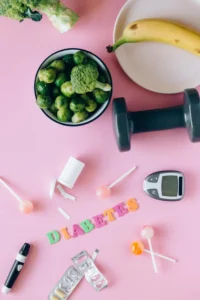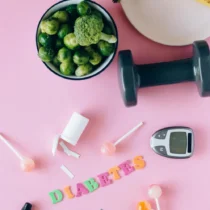Managing diabetes effectively requires careful attention to diet. The goal is to maintain stable blood sugar levels, achieve a healthy weight, and prevent complications. Here’s a guide on what to eat and what to avoid when living with diabetes:

What to Eat When You Have Diabetes
A diabetes-friendly diet focuses on nutrient-dense, low-glycemic foods that help regulate blood sugar levels. Here are some key recommendations:
1. Non-Starchy Vegetables
- These are low in calories and carbohydrates but high in fiber, vitamins, and minerals.
- Examples: Spinach, kale, broccoli, cauliflower, zucchini, cucumbers, bell peppers, and green beans.
2. Whole Grains
- Whole grains are rich in fiber, which slows down the absorption of sugar and helps control blood sugar levels.
- Examples: Quinoa, brown rice, oats, barley, whole wheat bread, and whole grain pasta.
3. Lean Proteins
- Protein helps stabilize blood sugar levels and keeps you feeling full longer.
- Examples: Skinless chicken, turkey, fish (like salmon, mackerel, and sardines), eggs, tofu, tempeh, and legumes (beans, lentils, chickpeas).
4. Healthy Fats
- Healthy fats improve heart health and help manage blood sugar levels.
- Examples: Avocados, nuts (almonds, walnuts), seeds (chia, flaxseed), olive oil, and fatty fish.
5. Low-Glycemic Fruits
- Fruits with a low glycemic index (GI) release sugar slowly into the bloodstream.
- Examples: Berries (strawberries, blueberries, raspberries), apples, pears, oranges, and kiwi.
6. Dairy or Dairy Alternatives
- Choose low-fat or non-fat options to avoid excess saturated fat.
- Examples: Greek yogurt, unsweetened almond milk, and low-fat cheese.
7. Fiber-Rich Foods
- Fiber slows digestion and helps prevent blood sugar spikes.
- Examples: Vegetables, fruits, whole grains, nuts, seeds, and legumes.
8. Herbs and Spices
- Some herbs and spices may help improve insulin sensitivity and add flavor without extra calories.
- Examples: Cinnamon, turmeric, ginger, and garlic.
What Not to Eat When You Have Diabetes
Certain foods can cause blood sugar spikes, contribute to weight gain, or increase the risk of complications. Here’s what to avoid or limit:
1. Sugary Foods and Beverages
- These can cause rapid spikes in blood sugar levels.
- Examples: Soda, fruit juices, candy, cakes, cookies, pastries, and ice cream.

2. Refined Carbohydrates
- Refined carbs are stripped of fiber and nutrients, leading to quick blood sugar spikes.
- Examples: White bread, white rice, pasta made from refined flour, and sugary cereals.
3. Trans Fats and Saturated Fats
- These fats can increase the risk of heart disease, which is already higher in people with diabetes.
- Examples: Fried foods, processed snacks (chips, crackers), margarine, and baked goods.
4. High-Sodium Foods
- Excess sodium can raise blood pressure, increasing the risk of heart disease.
- Examples: Processed meats (bacon, sausage, deli meats), canned soups, and salty snacks.
5. Sweetened Breakfast Foods
- Many breakfast foods are high in sugar and refined carbs.
- Examples: Sugary cereals, pancakes with syrup, and pastries.
6. Full-Fat Dairy
- High in saturated fat, which can negatively impact heart health.
- Examples: Whole milk, cream, and full-fat cheese.
7. Alcohol
- Alcohol can interfere with blood sugar control and should be consumed in moderation, if at all. Always consult your doctor before drinking.
Tips for a Diabetes-Friendly Diet
- Portion Control: Even healthy foods can raise blood sugar if eaten in large quantities. Use measuring tools or a food scale to manage portion sizes.
- Balanced Meals: Include a mix of carbohydrates, protein, and healthy fats in every meal to stabilize blood sugar.
- Regular Meal Timing: Eat at consistent times each day to avoid blood sugar fluctuations.
- Read Food Labels: Check for added sugars, sodium, and unhealthy fats in packaged foods.
- Stay Hydrated: Drink plenty of water and avoid sugary drinks.
- Cook at Home: Preparing meals at home allows you to control ingredients and portion sizes.
Idea for a Diabetes-Friendly Meal Plan
- Breakfast: Greek yogurt with berries and a sprinkle of chia seeds.
- Snack: A small handful of almonds or an apple with peanut butter.
- Lunch: Grilled chicken salad with mixed greens, cherry tomatoes, cucumbers, and olive oil dressing.
- Snack: Carrot sticks with hummus.
- Dinner: Baked salmon with quinoa and steamed broccoli.
- Dessert: A small piece of dark chocolate (70% cocoa or higher).
Conclusion
A diabetes-friendly diet doesn’t have to be restrictive or boring. By focusing on whole, nutrient-dense foods and avoiding processed, sugary, and high-fat options, you can manage your blood sugar levels effectively and improve your overall health. Always consult with a registered dietitian or healthcare provider to create a personalized meal plan that meets your specific needs and preferences. With the right approach, you can enjoy delicious, satisfying meals while keeping your diabetes under control.



